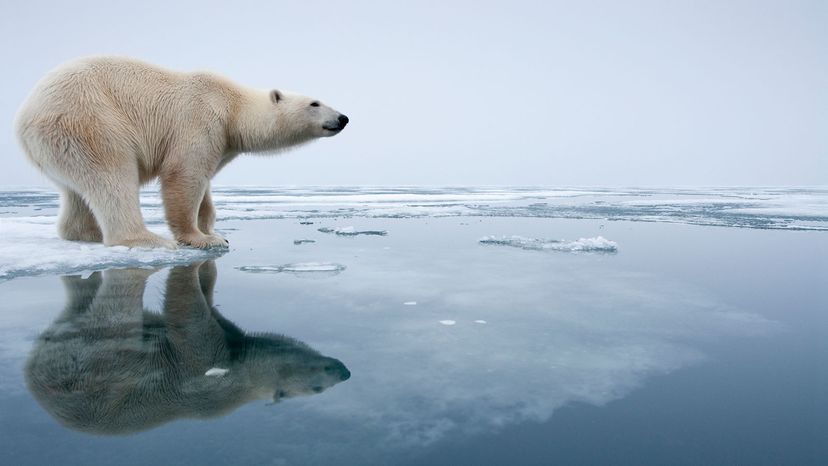Polar Bears and Climate Cage

Although the thought of a polar bear attack is scary, wildlife advocates are far more fearful about the potential impacts of climate change on this species' ecosystem. Global warming is causing distinct changes to the bear's habitat.
Namely, warming temperatures are melting Arctic sea ice, at rate of roughly 4 percent per decade [source: Carbon Brief]. Less sea ice means fewer hunting grounds for bears, which rely almost entirely on their seal stalking abilities to survive, sitting for hours on a piece of ice waiting for a seal to appear. Warmer conditions mean the ice forms later in winter and melting earlier in spring, so bears experience dwindling access to their primary food source. Some are forced to roam farther to find food, a startling development for animals that already spend about half of their waking hours hunting.
Advertisement
The extra energy they expend searching for sustenance sometimes takes a serious toll on bear nutrition and health. Scientists have documented bears losing significant body mass during these long hunting expeditions. In some cases, bears starve to death because they're simply unable to catch any seals [source: National Geographic].
But the news may not be all bad. "Although most of the world's 19 populations have returned to healthy numbers, there are differences between them," the World Wildlife Fund said in 2019. It noted that four populations were in decline due to climate-related stress, two were increasing, five were stable and eight had missing or outdated information.
In 2008, the U.S. listed polar bears as a threatened species under the Endangered Species Act [source: WWF]. In Canada, officials are still convinced that populations are stable and have opted to keep polar bears listed as a species of special concern, rather than escalating its status to threatened.
"In this community of scientists, it’s been known for some time that the international polar bear campaigns and their implicit story of the threat that the bear will go extinct are problematic," wrote Arctic Today in 2018. "The scientific guardians of the 19 populations of polar bear in the Arctic are connected through the Polar Bear Specialist Group under the UN’s International Union for Conservation of Nature, IUCN, and they never said that the polar bear will go extinct."
But even if the polar bear is not going extinct, that doesn't mean that polar bears are completely safe. It means that the story needs to be told differently, emphasizing the areas where polar bears are vulnerable as well as the stressing the climate change damage to the Arctic Circle in general and addressing the concerns of the people who live in that region as well.
Related Articles
More Great Links
Sources
- Animals in advertising. Bartolomeo Mecánico: Advertising studies. http://www.elve.net/panim/en/bear02.htm (Jan. 16, 2020)
- Cox, David. "Scientists Hatch Bold Plan to Save Polar Bears." NBC News. Feb. 26, 2018. https://www.nbcnews.com/mach/science/scientists-hatch-bold-plan-save-polar-bears-ncna851356 (Jan. 16, 2020)
- Heil, Nick. "Shoot or Spray? The Best Way to Stop a Charging Bear." Outside. May 7, 2012. https://www.outsideonline.com/1899301/shoot-or-spray-best-way-stop-charging-bear (Jan. 16, 2020)
- Leahy, Stephen. "Polar Bears Really Are Starving Because of Global Warming, Study Shows." National Geographic. Feb. 1, 2018. https://www.nationalgeographic.com/news/2018/02/polar-bears-starve-melting-sea-ice-global-warming-study-beaufort-sea-environment/ (Jan. 16, 2020)
- Moscowitz, Clara. "Polar Bears Evolved Just 150,000 Years Ago." Live Science. March 1, 2010. https://www.livescience.com/10956-polar-bears-evolved-150-000-years.html (Jan. 16, 2020)
- Mulvaney, Kieran. "'If it Gets Me, it Gets Me': the Town Where Residents Live Alongside Polar Bears." The Guardian. Feb. 13, 2019. https://www.theguardian.com/world/2019/feb/13/churchill-canada-polar-bear-capital (Jan. 16, 2020)
- Safety in Bear Country Society. "Polar Bears: A Guide to Safety." 2006. http://www.bearsmart.com/docs/polarbearsscript.pdf (Jan. 16, 2020)
- Polar Bears. Seaworld.org. https://seaworld.org/animals/all-about/polar-bear/ (Jan. 16, 2020)
- Polar Bear Facts. Kidzworld. http://www.kidzworld.com/article/430-wild-things-the-polar-bear (Jan. 16, 2020)
- Polar Bears International. http://www.polarbearsinternational.org/ (Jan. 16, 2020)
- Terra Daily. "Svalbard, Where Man and Polar Bears Share the Art of Living." March 16, 2008. http://www.terradaily.com/reports/Svalbard_where_man_and_polar_bears_share_the_art_of_living_999.html (Jan. 16, 2020)
- World Wildlife Fund. "Multiple Polar Bears Discovered Swimming Many Miles From Alaska Coast." Aug. 21, 2008. https://www.worldwildlife.org/press-releases/multiple-polar-bears-discovered-swimming-many-miles-from-alaska-coast (Jan. 16, 2020)
- World Wildlife Fund. "Polar Bear Diet." https://arcticwwf.org/species/polar-bear/diet/ (Jan. 16, 2020)